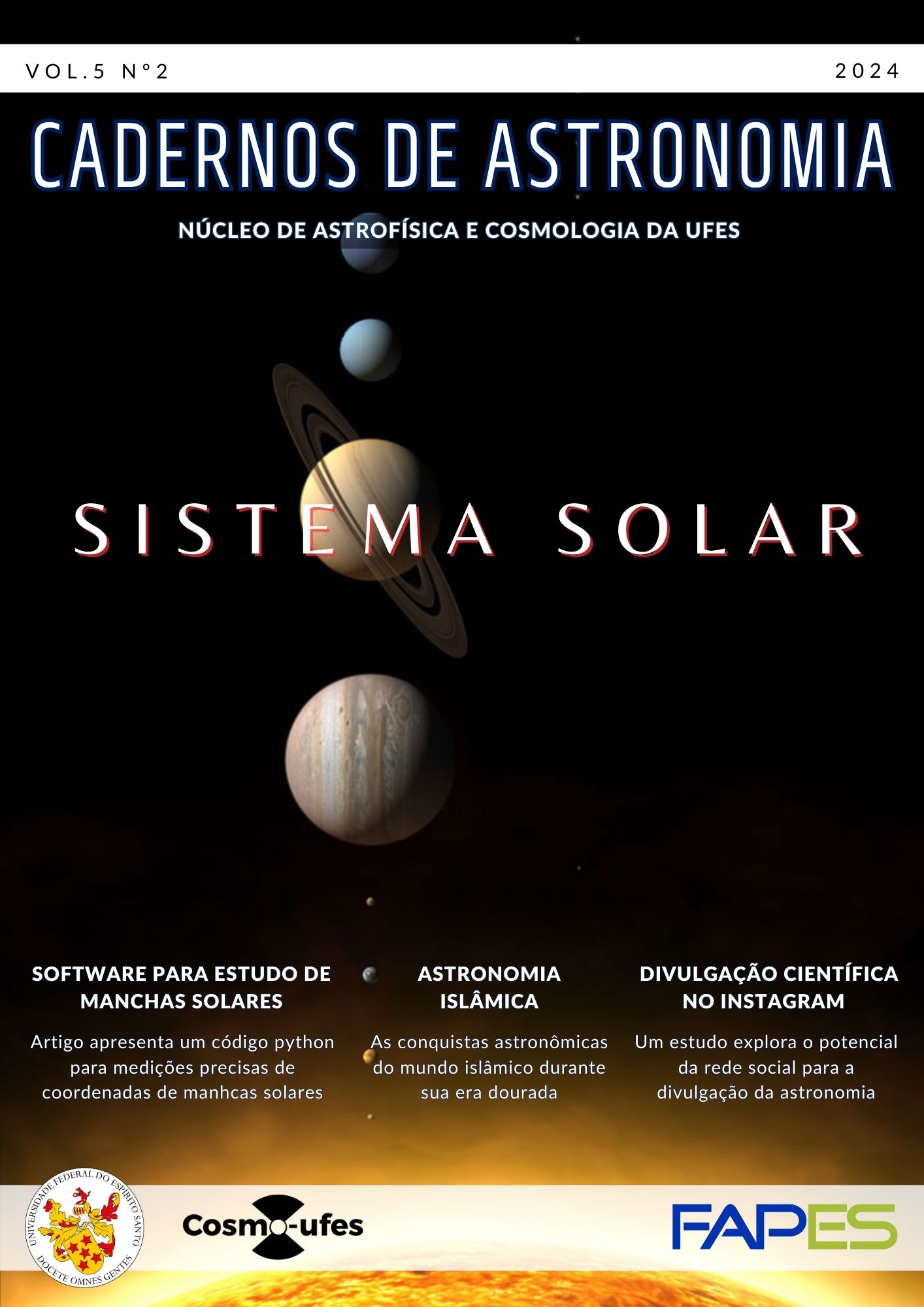Ocultações estelares: os 10 anos da descoberta dos anéis de Chariklo, e os avanços no estudo do Sistema Solar
DOI:
https://doi.org/10.47456/Cad.Astro.v5n2.45931Palabras clave:
Ocultações estelares, Anéis, pequenos corpos do Sistema Solar, ciência cidadãResumen
Há cerca de 10 anos anunciamos a descoberta do primeiro sistema de anéis ao redor de um pequeno corpo do Sistema Solar. A técnica de ocultações estelares, que permitiu o feito, vem sendo largamente utilizada para caracterizar objetos do Sistema Solar. Seu alto poder de resolução espacial tem permitido que dimensões e formas venham sendo obtidas, com grande precisão, para muitos objetos, desde aqueles próximos à Terra, até aqueles mais distantes do Sol. Além dos anéis de Chariklo descobertos em 2013, anéis já foram identificados ao redor do planeta-anão Haumea e do objeto transnetuniano Quaoar. Isto mostra que anéis podem ser comuns no Sistema Solar Exterior, já que limites previamente imaginados, como o Limite de Roche, não se aplicam à estes anéis. Os pesquisadores brasileiros e astrônomos cidadãos tem tido papel fundamental nesta pesquisa, a qual, graças ao LSST, deve expandir consideravelmente nos próximos anos.
Referencias
F. Braga-Ribas et al., A ring system detected around the Centaur (10199) Chariklo, Nature 508(7494), 72 (2014). ArXiv: 1409.7259.
F. Braga-Ribas et al., Database on detected stellar occultations by small outer Solar System objects, Journal of Physics: Conference Series 1365(1), 012024 (2019).
B. Sicardy et al., Constraints on Charon’s Orbital Elements from the Double Stellar Occultation of 2008 June 22, The Astronomical Journal 141(2), 67 (2011).
J. L. Ortiz et al., Albedo and atmospheric constraints of dwarf planet Makemake from a stellar occultation, Nature 491(7425), 566 (2012).
E. Meza et al., Lower atmosphere and pressure evolution on Pluto from ground-based stellar occultations, 1988-2016, Astronomy & Astrophysics 625, A42 (2019). ArXiv: 1903.02315.
J. Marques Oliveira et al., Constraints on the structure and seasonal variations of Triton’s atmosphere from the 5 October 2017 stellar occultation and previous observations, Astronomy & Astrophysics 659, A136 (2022). ArXiv:2201.10450.
F. Braga-Ribas et al., Constraints on (2060) Chiron’s size, shape, and surrounding material from the November 2018 and September 2019 stellar occultations, Astronomy & Astrophysics 676, A72 (2023). ArXiv:2308. 10042.
C. L. Pereira et al., The two rings of (50000) Quaoar, Astronomy & Astrophysics 673, L4 (2023). ArXiv:2304.09237.
A. Dias-Oliveira et al., Study of the Plutino Object (208996) 2003 AZ84 from Stellar Occultations: Size, Shape, and Topographic Features, The Astronomical Journal 154(1), 22 (2017). ArXiv:1705.10895.
F. L. Rommel et al., A large topographic feature on the surface of the trans-Neptunian object (307261) 2002 MS4 measured from stellar occultations, Astronomy & Astrophysics 678, A167 (2023). ArXiv:2308.08062.
A. A. Sickafoose et al., A stellar occultation by Vanth, a satellite of (90482) Orcus, Icarus 319, 657 (2019). ArXiv:1810.08977.
F. Braga-Ribas et al., Present and Future of Stellar Occultation by Transneptunian Satellites and Binaries and their use to update the orbits of Vanth and Weywot (2024), submetido ao Philosophical Transactions A.
E. Fernández-Valenzuela et al., Physical properties of Hi’iaka from stellar occultation data 53(7) (2021). Disponível em https://baas.aas.org/pub/2021n7i503p05, acesso em set. 2024.
F. L. Rommel et al., Physical properties of (38628) Huya and its satellite from stellar occultations (2024), submetido ao Planetary and Space Journal.
M. Assafin, Differential aperture photometry and digital coronagraphy with PRAIA, Planetary and Space Science 239, 105816 (2023). ArXiv:2311.14152.
A. R. Gomes-Júnior et al., SORA: Stellar Occultation Reduction and Analysis, Monthly Notices of the Royal Astronomical Society (2022). ArXiv:2201.01799.
F. Braga-Ribas et al., The Size, Shape, Albedo, Density, and Atmospheric Limit of Transneptunian Object (50000) Quaoar from Multi-chord Stellar Occultations, The Astrophysical Journal 773(1), 26 (2013).
J. L. Ortiz et al., The size, shape, density and ring of the dwarf planet Haumea from a stellar occultation, Nature 550(7675), 219 (2017). ArXiv:2006.03113.
B. E. Morgado et al., A dense ring of the trans-Neptunian object Quaoar outside its Roche limit, Nature 614(7947), 239 (2023).
J. L. Ortiz et al., Changing material around (2060) Chiron revealed by an occultation on December 15, 2022, Astronomy & Astrophysics 676, L12 (2023). ArXiv:2308.03458.
D. Bérard et al., The Structure of Chariklo’s Rings from Stellar Occultations, The Astronomical Journal 154(4), 144 (2017). ArXiv:1706.00207.
B. E. Morgado et al., Refined physical parameters for Chariklo’s body and rings from stellar occultations observed between 2013 and 2020, Astronomy & Astrophysics 652, A141 (2021). ArXiv:2107.07904.
P. Santos-Sanz et al., The rings of Centaur Chariklo revealed by a stellar occultation observed by JWST, Bulletin of the AAS 55(8) (2023). Disponível em https://baas.aas.org/pub/2023n8i301p07, acesso em set. 2024.
J. L. Ortiz et al., Possible ring material around centaur (2060) Chiron, Astronomy & Astrophysics 576, A18 (2015). ArXiv: 1501.05911.
A. A. Sickafoose et al., Material Around the Centaur (2060) Chiron from the 2018 November 28 UT Stellar Occultation (2023). ArXiv:2310.16205.
B. Sicardy et al., Ring dynamics around non-axisymmetric bodies with application to Chariklo and Haumea, Nature Astronomy 3, 146 (2019). ArXiv:1811.09437.
Y. Kilic et al., Occultation portal: A web-based platform for data collection and analysis of stellar occultations, Monthly Notices of the Royal Astronomical Society 515(1), 1346 (2022). ArXiv:2206.09615.
Descargas
Publicado
Número
Sección
Licencia
Derechos de autor 2024 Felipe Braga Ribas

Esta obra está bajo una licencia internacional Creative Commons Atribución 4.0.






